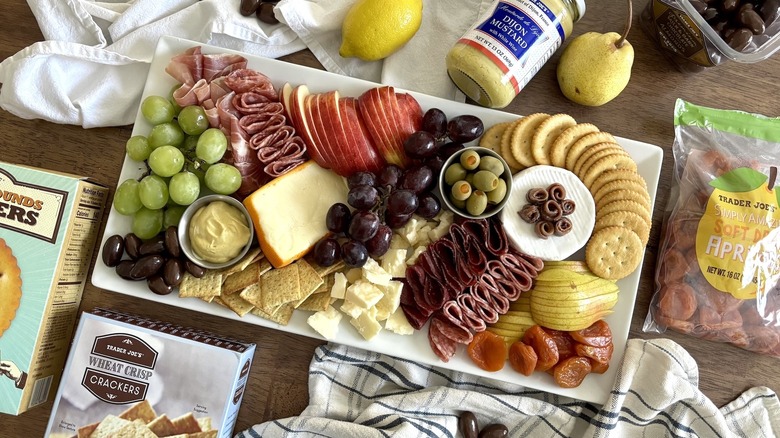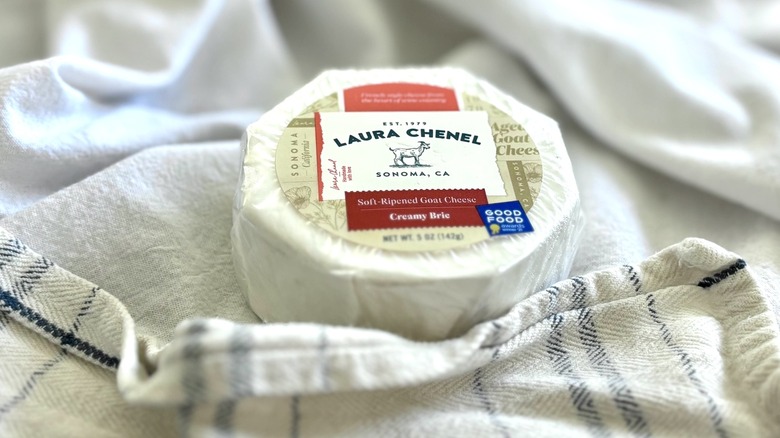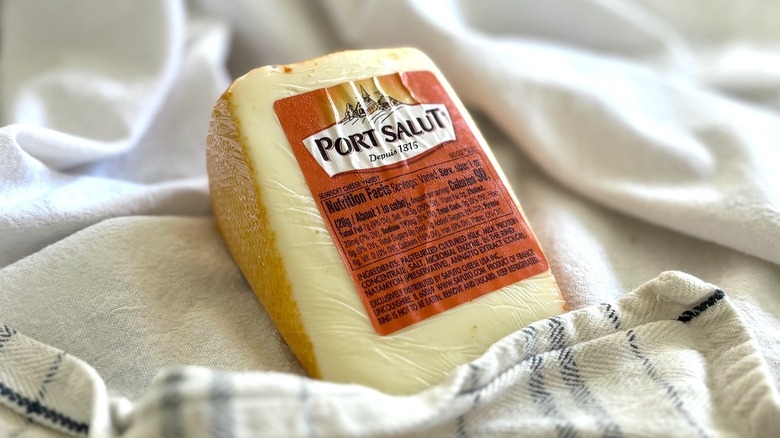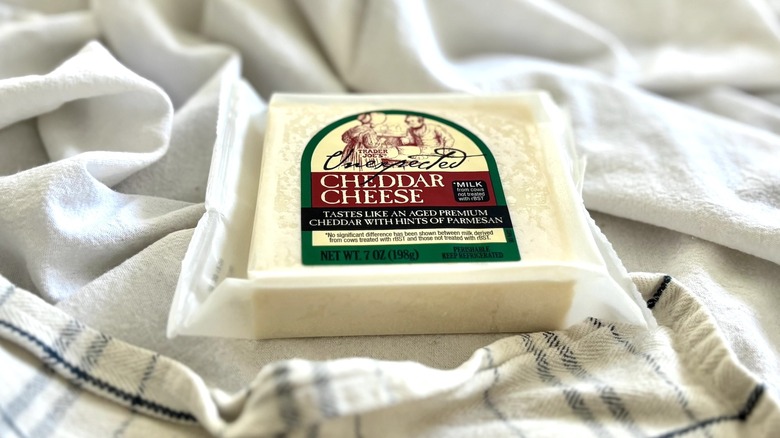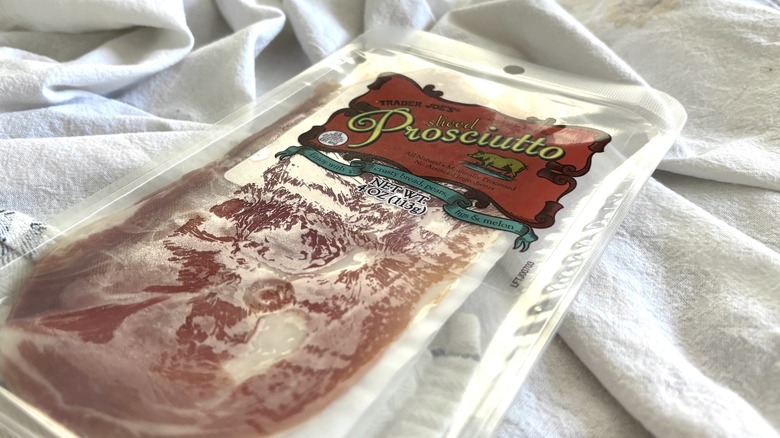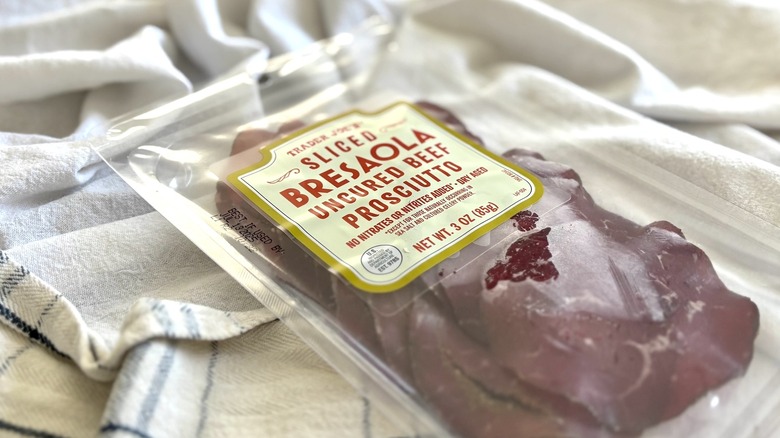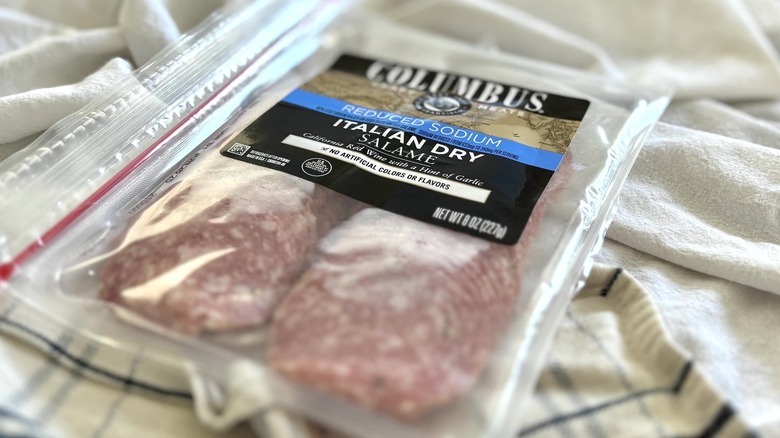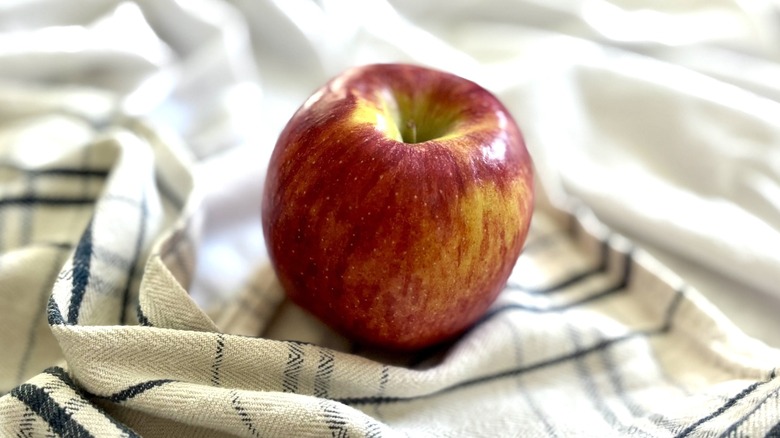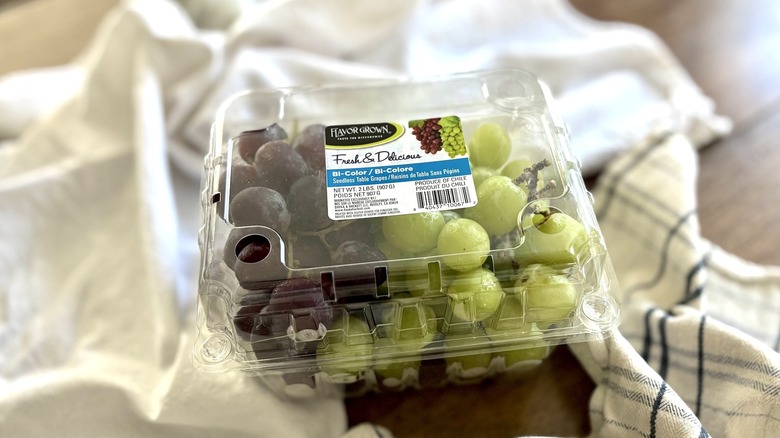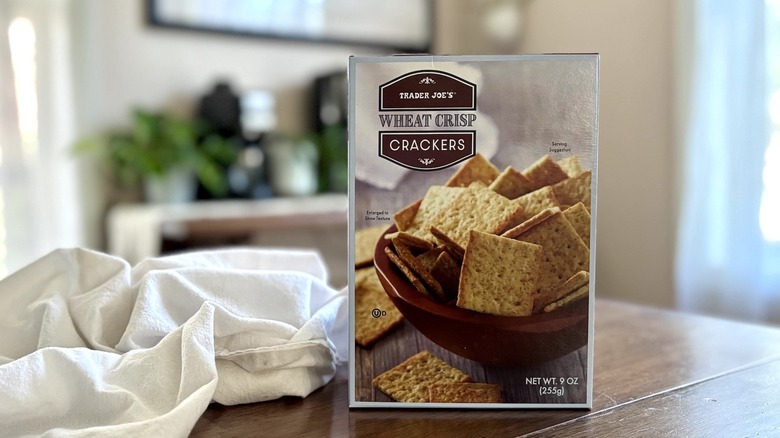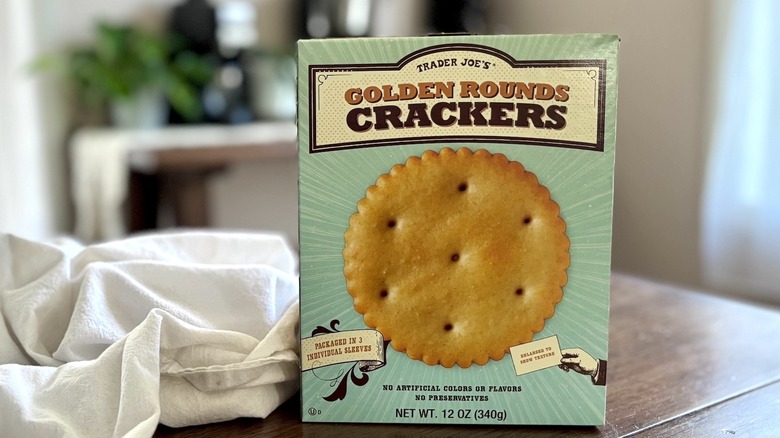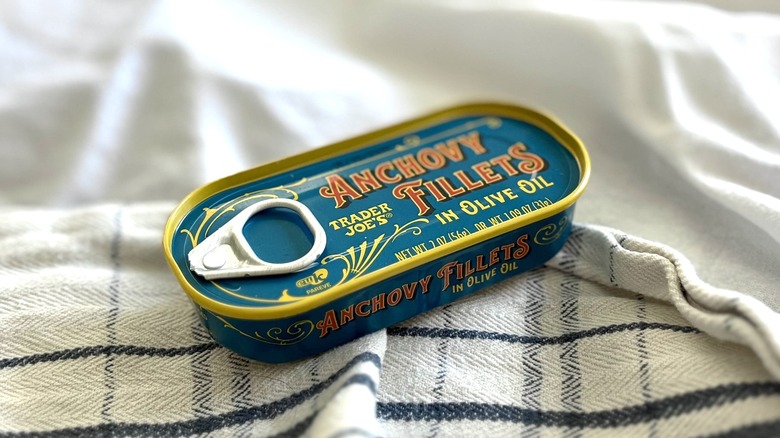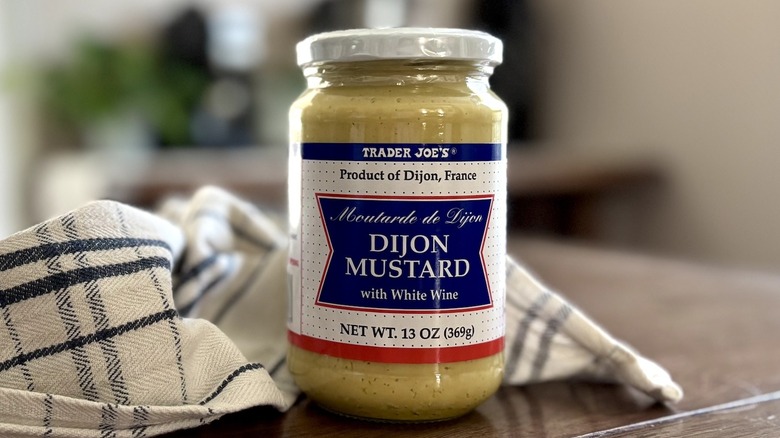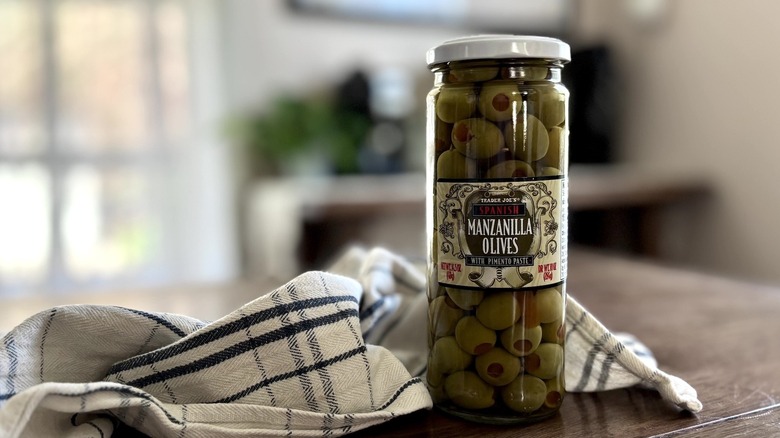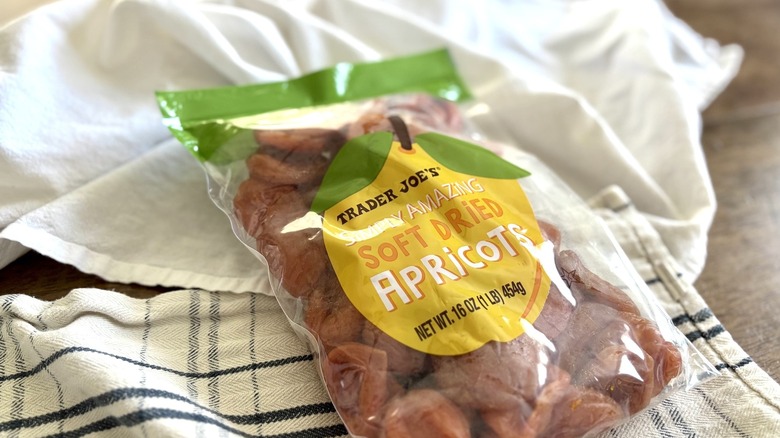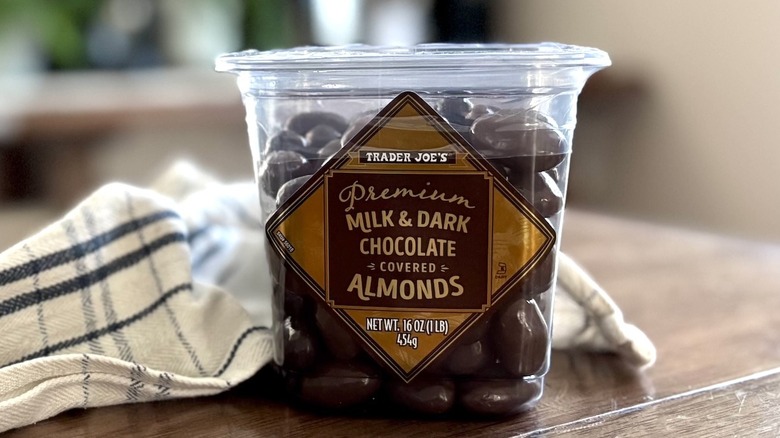How To Build The Ultimate Charcuterie Board At Trader Joe's
We may receive a commission on purchases made from links.
We all love a good charcuterie board, but let's be honest, we don't love paying for it. That's where trusty old Trader Joe's comes in. Between reliably stocked items and low prices, you can always find enough goodies to build out a great snack or dinner tray. Indeed, I recently had the opportunity to put this statement to the test and create a board, and I learned a few things along the way. Prices mentioned are accurate as of April 2025 and dependent on location.
First up, amounts matter. Advice varies, but a good rule of thumb is to buy 2 ounces of meat and 2 ounces of cheese per person for an appetizer platter, according to Zingerman's Mail Order Head of Marketing & Product Selection, Brad Hedeman. If it's for a meal, though, triple the amount to make sure everyone gets enough. And if you're catering to vegetarians with a cheese-only platter, plan accordingly. Then use the 3:3:3:3 ratio, as Breen Halley of Halley Events advised when commenting on charcuterie board mistakes: three meats, three cheeses, three types of produce, and three accompaniments.
Then it's time to build your board ingredient by ingredient. In general, you should follow some expert-approved tips, like placing large items first, arranging smaller items around them, and including plenty of crackers and/or bread. You might want to pick up a few serving items, such as the SMIRLY Charcuterie Boards Set or a Lunar 6-Piece Cheese Knife Set, or just use what you have at home.
Anchor with a creamy Brie, like Laura Chenel soft-ripened goat cheese
Once you have your headcount, select a large enough vessel. Cutting boards, flat serving dishes, slate slabs, and even plastic-wrap-covered tables all work. George Guzman, executive chef of the Mediterranean-inspired NYC wine bar Carta, recommends using a board that's large enough to show off your display without crowding.
First item: a soft cheese, but not just any soft cheese. There are some charcuterie board ingredients to avoid, like stinky cheeses and super runny Camembert. The basic rule is not to overpower the other ingredients on your board. Also remember that some cheeses, especially semi-soft and soft ones, are better at room temp. There is a science behind this: A lot of the flavor of cheese is contained in its fat, and cold fat molecules are hard for our taste buds to experience. The cheese also gets softer and creamier as it warms. Let it come to room temperature, unwrapped and loosely covered, for at least an hour.
For the soft option, I chose the Laura Chenel Soft Ripened Goat Cheese from Trader Joe's, which was $5.99 and completely delicious. Because I was using a ceramic platter, I set it right on the dish. However, when I'm using a wooden board, I often like to use Parchment Paper Leaves for Cheese & Charcuterie Boards to protect it from the surface. Up to you.
Add a semisoft option, like Port Salut
Next up, you'll want a semisoft option for your charcuterie board. I wasn't sure exactly which direction to go, so I let the overall theme guide me. Because it's my favorite, I chose a Mediterranean theme, but there are plenty of others: summer picnic, grill platter, game day, fruit picking, Greek, autumn, holidays, nuts and cheeses, you name it. You can also just get what looks good. A book like "That Cheese Plate Will Change Your Life" can help lend inspiration. Any of these options, however, are easy to achieve at Trader Joe's.
Ultimately, I went with a classic Port Salut, which cost $5.16 for the piece I bought (priced by the pound) and was worth every penny. I love it wrapped in salami, but it's amazing on crackers and bread as well, and it even goes with jam, especially fig. Just like the Brie, it needs to come to room temperature to become soft and a bit spreadable. Place the two cheeses well apart on the board for visual and textural balance.
Select a hard cheese, such as Unexpected cheddar cheese
Last up, every charcuterie board should have a hard cheese, again to meet the need for textural balance. Trader Joe's has no lack of options, but to save money, I went for the store brand Unexpected Cheddar Cheese for $3.99. It tasted like an aged white cheddar with, as the label said, "hints of Parmesan," which is a great way to offer a sharper flavor without overwhelming the other options. It's also an ideal choice to stand up to the butteriness of crackers and the sweetness of apples.
This cheese was also nice because it wasn't too crumbly, which is a characteristic of some aged cheddars. It had a crystalline interior, so I chunked it instead of cutting to prevent crumbling, and the chunks held together well. Plus, it made the board look more interesting to have a different shape on it. A final note on cheeses: Whether you slice them beforehand or put whole cheeses with knives on the board (which is the way we've always done it in our family), make sure they're easy to access without contaminating the rest of the food. This is especially important with a group.
Fold sliced prosciutto onto the board
Everyone loves prosciutto. It's an endlessly versatile food that looks and tastes beautiful on its own but is also delicious wrapped around peaches, cantaloupe slices, asparagus, or figs. Honestly, you could wrap it around a twig, and I'd probably accept the challenge. Trader Joe's Sliced Prosciutto was $4.29 and tasted great.
I chose not to wrap anything for the charcuterie board, but had to consider the fact that prosciutto is in danger of looking very flat if not handled right. Happily, folding charcuterie meats makes the board look much more appealing and maintains visual interest. Even better, clever chefs have developed innumerable ways to fold charcuterie, so I took to the internet. Google "prosciutto fans" and you'll find the same tutorial I did. Life skill, unlocked. Don't just pile it in one place, though. Rather, create a sense of flow by creating meat "rivers" that wind through the board.
Add an unusual meat, like sliced bresaola
When you're making your tray at home, you have the option to avoid boring or sus ingredients, both of which are red flags with restaurant charcuterie boards. One of the best ways to do this is to think outside the meat box. No, that doesn't mean wearing a meat dress à la Lady Gaga at the 2010 MTV Video Music Awards. Rather, look for options you've never tried before.
I always stick to pork for my boards, so I decided to try Trader Joe's Sliced Bresaola Uncured Beef Prosciutto for $6.99. It was definitely interesting, with a rougher and gamier texture than pork products. It lacks that silky feel I associate with cured meat, being closer to roast beef than prosciutto, but it accomplished the goal of a different texture. Plus, the red-wine color looked beautiful next to the Brie.
To fold it, simply take a piece (they're round) and fold it into quarters. Then do it again, flipping the meat so that the highest corner is on the opposite side this time. Keep it up, sticking each piece next to the last, until you have a different type of prosciutto river. Once you've got a good stack going in your hands, lay it down on the board and add more if needed.
Select a standby salami, like Columbus Italian dry salame
Of course, it can't all be experimentation when selecting options for your charcuterie board. Well, it can, but at your own risk ... when I'm trying to make a nice spread, I like to choose some options that I know are tried-and-true. Our house favorite is salami, so I picked a somewhat boring but always trusty standby from my experience: Columbus Italian Dry Salame for $5.29.
I folded this meat the same way as the bresaola, but because it was smaller and more thickly cut the texture came out different. Since there was so much contrast between the two despite the same folding method (it had a distinctly different color), I ended up placing one salami river next to the bresaola and one next to the prosciutto, where the color was similar but the shape was different. Folded meat, people. It's where it's at.
Slice Envy apples
No charcuterie board is complete without fruit. Remember the 3:3:3:3 rule, discussed above: You should have three types of produce, as well as three meats, cheeses, and accompaniments. For the fruit, I chose apples, pears, and grapes. First, every American knows and likes these options, for the most part, so they're reliable players on a charcuterie board of pretty much any theme. Second, Trader Joe's doesn't have the widest fruit selection, but you can almost always find these year-round.
The Envy apples looked good when I went in, and at only $1.49 each, they were a definite steal compared to the prices at my neighborhood grocery store. Make sure to get a crisp specimen with no soft spots or bruises, which will ruin the appearance of the exposed flesh once you cut them up. When placing them on the board, you can either fan them out or slice them and leave them loosely bunched in their rounded form. I opted for the latter.
Cut up Anjou pears
While similar to apples, pears bring a lovely, gentle softness to the flavors of a salty charcuterie board. Trader Joe's had Anjou pears for only $.79 each, so I got two and went bananas with the display. I prepared them the same way I did with the apples, cutting them off the stem and then slicing them thinly so that their pretty green exterior was the star of the show.
Make sure if you're using anything that browns, such as apples or pears, to coat them in a bit of lemon juice. That way, they won't become discolored while you're putting your board together or waiting for guests to arrive. At only $.49 for a lemon at Trader Joe's, it's certainly worth the investment to protect your gorgeous creation from the consequences of oxidation.
Snip up bi-color grapes
Part of the reason I love charcuterie boards so much is that I grew up eating them for every birthday and holiday as a child. We didn't have a fancy word for it back then, so we just called it finger food, but the idea was the same: piles of meat, cheese, and fruit all bunched together in an abundant spread. One of my parents' favorite additions was grapes, and if they were to be had at the store, we got them.
This bit of nostalgia means I always have to add grapes to any board, and luckily Trader Joe's has a nice option: 2 pounds of Flavor Grown Bi-Color Grapes for $6.49. Wash them, then snip their stems to create bunches of five to six grapes so people don't have to tear them off when serving.
Set out some square wheat crisp crackers
Don't forget bread or crackers. These aren't the spendiest or most exciting offerings on your charcuterie board, but they are mission-critical: You need a vehicle for getting the proteins from board to mouth without incident. Here's where the store's prices really shine: Trader Joe's Wheat Crisp Crackers are only $2.49, and they're really good. They have a sharp snap but don't cut your mouth, and they're small enough to pop in whole, even with meat and cheese on top.
Whatever large spaces you have left should be filled with a generous assortment of crackers, and be sure to keep the boxes nearby to refill as necessary. Don't pile them so high that you drown the board, though, instead try to keep a uniform appearance. If you find you can't fit everything on the charcuterie board in the correct ratios, you may need a larger platter.
Include some buttery Golden rounds
Of course, one type of cracker is never enough. I could have gone for a baguette for the second option, but I was planning to snack on this board for several days, so I decided crackers would keep longer. My second choice was the Trader Joe's Golden Rounds Crackers for $2.99. These are essentially Ritz in different packaging, so the classic brand would work equally well.
These crackers, like a baguette, are mild and not too salty. That's important, because so many of the items on the board have lots of sodium — especially the charcuterie — so you want at least one of your carb items to contain very little, so as to cut the sharpness. Plus, their round shape makes them perfectly suited to creating a delicate arc, which is a really fun way to highlight the Brie wheel in the corner of the board.
Garnish with a tin of anchovy fillets in olive oil
Many people think seafood belongs nowhere near a charcuterie board, but that couldn't be further from the truth. Indeed, canned seafood is an ideal snack board option, which is why I made sure to grab a tin of fish. The Trader Joe's Anchovy Fillets in Olive Oil were only $1.79, and they were deliciously salty — the perfect accompaniment to the mild goat's milk Brie. They were also good all by themselves on crackers.
However, many people don't like tinned fish, and the flavor can be very strong. While I rolled up the anchovies and placed them on top of the Brie wheel in a flower pattern, you should be more circumspect if you're not sure what your guests like. To be more cautious, open the tin, leave the fish inside, and place it on its own plate to catch the oils that inevitably drip out when serving. Remember to put out a serving utensil for each item that can't easily be picked up by hand.
Put out Dijon mustard
Mustard is a perfect accompaniment to so many different types of charcuterie boards, because its sharp bite both cuts through saltiness and enhances milder cheese and cracker flavors. I chose the Trader Joe's Dijon Mustard with White Wine for $1.99. Having never tasted it, I wasn't sure what to expect, but it didn't disappoint and had a good white wine flavor that set it apart. This is a pretty pungent mustard, though, so beware.
Always transfer mustard into a separate vessel so it doesn't touch other ingredients. Try to place it where it will fill large gaps in the board left by the meats, cheeses, crackers, and fruit. Remember to put a serving spoon with it, but make it small. The WM Bartleet & Sons Traditional Porcelain Salt, Condiment, and Spice Spoons or Hiware 6-Piece Demitasse Espresso Spoons would both work well for this purpose.
Adorn with Manzanilla olives
Next on the charcuterie board go the small ingredients: berries, nuts, olives, dried fruit, and chocolate-covered items. For one of the three accompaniments, I chose Trader Joe's Spanish Manzanilla Olives with Pimiento Paste. At only $2.99 for a decent-sized jar, they're a steal. I put plenty on the board and still had lots of leftovers to enjoy later. They provide the perfect salty bite after a cracker with mild cheese, and they contrast nicely with the fruit.
Make sure to arrange small items in groupings instead of scattering them across the tray evenly. A good charcuterie board should have clumps of ingredients so your eye can instantly tell what is where. If you're dishing out items in bowls because they're wet or you don't want them touching anything else, be sure to use a cute container, such as DOWAN Porcelain Ramekins.
Incorporate dried fruit, like apricots
Last up, make sure to add dried fruit to your charcuterie board. It always goes well with cheese and gives guests a treat with which to finish off their meal. Trader Joe's Simply Amazing Soft Dried Apricots are epically delicious. The label doesn't lie: They are actually the softest apricots I've ever had, courtesy of the sulfites, but still, they're yummy. At only $4.79 for the bag and plenty of leftovers, I was very satisfied with my choice.
Like any other offering on the board, make sure to set out your fruit in a little pile or river. In this case, I ended up filling an empty space on the board near the pears, as the two were complementary flavors. That also kept the apricots away from the crackers and cheese so that nothing got sticky.
Don't forget a dessert, such as milk & dark chocolate covered almonds
Last up, dessert. I chose Trader Joe's Premium Milk & Dark Chocolate Covered Almonds. At $7.49, these were the most expensive item on the menu, but for good reason. You not only get a huge container, but it has both milk and dark chocolate options, which is perfect for my partner and I — I like dark chocolate, he likes milk. Bunch the almonds loosely in any open spaces left on the board, then garnish if you wish.
If you're serving any kind of seafood, e.g. tinned anchovies, then you might want to toss a few lemon wedges around the board. You can add herbs or flowers to your taste, but you've got to make sure they're really edible if you forage, so do your research. You can also "garnish" the board at the beginning by laying down cheese leaves, but you'll need to have more space in your arrangement so that they remain visible.
Lastly, place plates, napkins, personal utensils (if needed), glasses, and drinks nearby. Stylish Gold Cocktail Napkins are a nice addition to a fancier evening, but for a cozy meal for two, just use what you already have on hand. Et voilà: Date night achieved, with multiple meals' worth of leftovers, for less than $70!
